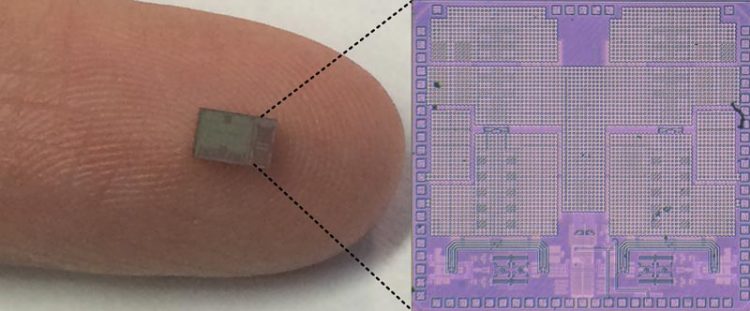New Technology May Double Radio Frequency Data Capacity

Image courtesy Jin Zhou and Harish Krishnaswamy, Columbia Engineering CoSMIC (Columbia high-Speed and Mm-wave IC) Lab full-duplex transceiver IC that can be implemented in nanoscale CMOS to enable simultaneous transmission and reception at the same frequency in a wireless radio.
A team of Columbia Engineering researchers has invented a technology—full-duplex radio integrated circuits (ICs)—that can be implemented in nanoscale CMOS to enable simultaneous transmission and reception at the same frequency in a wireless radio. Up to now, this has been thought to be impossible:
transmitters and receivers either work at different times or at the same time but at different frequencies. The Columbia team, led by Electrical Engineering Associate Professor Harish Krishnaswamy, is the first to demonstrate an IC that can accomplish this. The researchers presented their work at the International Solid-State Circuits Conference (ISSCC) in San Francisco on February 25.
“This is a game-changer,” says Krishnaswamy. “By leveraging our new technology, networks can effectively double the frequency spectrum resources available for devices like smartphones and tablets.”
In the era of Big Data, the current frequency spectrum crisis is one of the biggest challenges researchers are grappling with and it is clear that today's wireless networks will not be able to support tomorrow's data deluge. Today's standards, such as 4G/LTE, already support 40 different frequency bands, and there is no space left at radio frequencies for future expansion. At the same time, the grand challenge of the next-generation 5G network is to increase the data capacity by 1,000 times.
So the ability to have a transmitter and receiver re-use the same frequency has the potential to immediately double the data capacity of today's networks. Krishnaswamy notes that other research groups and startup companies have demonstrated the theoretical feasibility of simultaneous transmission and reception at the same frequency, but no one has yet been able to build tiny nanoscale ICs with this capability.
“Our work is the first to demonstrate an IC that can receive and transmit simultaneously,” he says. “Doing this in an IC is critical if we are to have widespread impact and bring this functionality to handheld devices such as cellular handsets, mobile devices such as tablets for WiFi, and in cellular and WiFi base stations to support full duplex communications.”
The biggest challenge the team faced with full duplex was canceling the transmitter's echo. Imagine that you are trying to listen to someone whisper from far away while at the same time someone else is yelling while standing next to you. If you can cancel the echo of the person yelling, you can hear the other person whispering.
“If everyone could do this, everyone could talk and listen at the same time, and conversations would take half the amount of time and resources as they take right now,” explains Jin Zhou, Krishnaswamy’s PhD student and the paper’s lead author. “Transmitter echo or ‘self-interference’ cancellation has been a fundamental challenge, especially when performed in a tiny nanoscale IC, and we have found a way to solve that challenge.”
Krishnaswamy and Zhou plan next to test a number of full-duplex nodes to understand what the gains are at the network level. “We are working closely with Electrical Engineering Associate Professor Gil Zussman's group, who are network theory experts here at Columbia Engineering,” Krishnaswamy adds. “It will be very exciting if we are indeed able to deliver the promised performance gains.”
This work was funded by the DARPA RF-FPGA program.
Contact Information
Holly Evarts
Director of Strategic Communications and Media Relations
holly.evarts@columbia.edu
Phone: 212-854-3206
Mobile: 347-453-7408
Media Contact
More Information:
http://www.columbia.eduAll latest news from the category: Power and Electrical Engineering
This topic covers issues related to energy generation, conversion, transportation and consumption and how the industry is addressing the challenge of energy efficiency in general.
innovations-report provides in-depth and informative reports and articles on subjects ranging from wind energy, fuel cell technology, solar energy, geothermal energy, petroleum, gas, nuclear engineering, alternative energy and energy efficiency to fusion, hydrogen and superconductor technologies.
Newest articles

NASA: Mystery of life’s handedness deepens
The mystery of why life uses molecules with specific orientations has deepened with a NASA-funded discovery that RNA — a key molecule thought to have potentially held the instructions for…

What are the effects of historic lithium mining on water quality?
Study reveals low levels of common contaminants but high levels of other elements in waters associated with an abandoned lithium mine. Lithium ore and mining waste from a historic lithium…

Quantum-inspired design boosts efficiency of heat-to-electricity conversion
Rice engineers take unconventional route to improving thermophotovoltaic systems. Researchers at Rice University have found a new way to improve a key element of thermophotovoltaic (TPV) systems, which convert heat…



